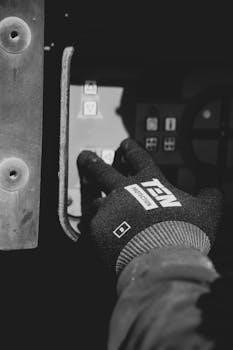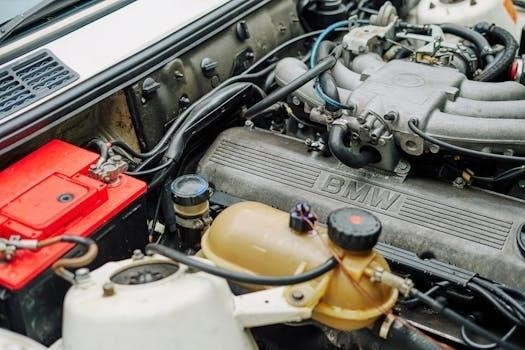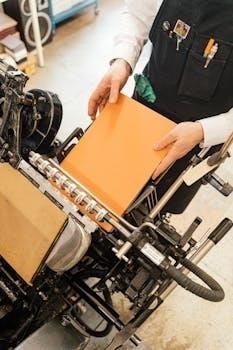Manual machine presses, also known as arbor presses, are operated by hand using a lever. These presses generate force through leverage, and are commonly utilized in various industries for tasks requiring precision and control.
What is a Manual Machine Press?
A manual machine press is a mechanical device powered by human force, typically using a lever to apply pressure. These presses, often called arbor or workshop presses, employ a ram that moves linearly, generating force for various operations. They are distinct from hydraulic or pneumatic presses, relying solely on manual effort for operation. Manual presses are simple, cost-effective tools used in diverse settings for tasks requiring controlled force.
Types of Manual Presses
Manual presses come in several types, including arbor, fly, and ball presses. Each type has unique features and is designed for specific tasks, offering versatility in various applications.
Arbor Presses
Arbor presses are manually operated presses that utilize a rack and pinion system to apply force. They are also sometimes referred to as workshop presses. These presses are commonly used for light-duty tasks such as pressing bearings, bushings, and performing assembly work with precision. The simple and robust construction of arbor presses makes them a reliable tool for various applications requiring controlled manual pressure.
Fly Presses
Fly presses, another type of manual press, utilize a weighted flywheel to generate force. This flywheel is rotated by hand, and the momentum is transferred to the ram for pressing operations. Fly presses are known for their versatility and are often used for tasks like stamping, forming, and light forging. They are robust and suited for applications requiring greater impact force compared to arbor presses, while still being manually operated.
Ball Presses
Ball presses are manual presses designed for tasks requiring high precision and control. They often feature a ball-shaped handle or lever mechanism, allowing for smooth and accurate application of force. These presses are commonly used in industries such as electronics and jewelry making, where delicate operations are performed. Their construction ensures durability and efficiency in handling specific, intricate assembly tasks, demanding a steady hand and fine control from the operator.

Key Components of a Manual Press
Manual presses typically consist of a C-frame for structure, and a ram that moves linearly. A lever system provides the force needed for operations. These components work together to apply pressure.
C-Frame Construction
The C-frame is a fundamental structural element of many manual presses. This design provides the necessary rigidity and support to withstand the forces generated during operation. The C-shaped structure allows for easy access to the work area, facilitating the placement and removal of materials. This frame is usually made from robust materials, ensuring the press’s stability and durability, which are vital for precise and safe operation.
Ram and Lever System
The ram and lever system is crucial for the functionality of a manual press. The operator applies force to the lever, which in turn moves the ram in a linear motion. This system allows the operator to exert force on a workpiece. The ram is the component that directly applies pressure, while the lever provides the mechanical advantage necessary to increase force applied by the user, making it suitable for various tasks.

Applications of Manual Presses
Manual presses are versatile tools used in various industries. They are ideal for tasks like sample preparation, small-scale production, and specific assembly operations, offering precision and control.
Small-Scale Manufacturing
Manual presses are perfectly suited for small-scale manufacturing environments where cost-effectiveness and simplicity are key. They excel in producing small components and handling short production runs. These presses can be used for various tasks, including punching, blanking, bending, and assembly. Their manual operation allows for quick adjustments and flexibility, making them ideal for workshops needing adaptable equipment for light-duty tasks and prototyping. Manual presses provide an economical solution for businesses that do not require the automation of larger scale operations.
Laboratory Sample Preparation
Manual presses are frequently used in laboratories for sample preparation due to their precise control and ability to apply consistent pressure. These presses are ideal for tasks such as creating pellets for XRF analysis, where uniform pressure is necessary. The manual nature of these presses allows researchers to have a high degree of control over the process, making them valuable tools for various scientific procedures. Their small footprint also makes them suitable for benchtop laboratory work, where space is often limited.
Metal Forming and Assembly
Manual presses play a significant role in metal forming and assembly processes, particularly in small-scale production settings. They are used for various operations, including bending, punching, riveting, and staking. These presses offer the advantage of precise control over the applied force, which is crucial for delicate assembly tasks. Their simplicity and cost-effectiveness make them a viable option for workshops and smaller manufacturing facilities where high-volume production is not the primary focus. The ability to perform multiple metal-forming tasks with one machine also adds to their versatility.
Advantages of Using Manual Presses
Manual presses are cost-effective, requiring no electricity, and are straightforward to operate. They offer a high degree of precision and control, making them ideal for specific applications.
Cost-Effective
Manual presses present a significant advantage in terms of cost, as they do not require electricity or complex hydraulic systems to function, reducing both initial investment and operational expenses. Their simple design and low maintenance needs further contribute to their affordability, especially for small-scale operations or workshops with limited budgets. This makes them a practical option for tasks where high-volume production is not a necessity.
Simple Operation
Manual presses are renowned for their straightforward operation, requiring minimal training to use effectively. The basic mechanism of a lever and ram allows for intuitive control, enabling operators to quickly understand and perform various tasks. The absence of complex controls makes them easily accessible, facilitating quick setup and operation, thus reducing learning curves and enhancing efficiency in various production and laboratory settings.
Precision and Control
Manual presses offer operators a high degree of precision and control over the applied force and movement. This is achieved through direct manual input, allowing for fine adjustments in pressure and stroke length. The operator can carefully modulate the force, making manual presses suitable for delicate tasks where accuracy is crucial, such as assembly work or sample preparation, ensuring consistent results without damaging the workpiece.

Disadvantages of Manual Presses
Manual presses are limited by the force an operator can physically exert. The manual operation can also be slow, making them unsuitable for large-scale production requiring speed and high force.
Limited Force
Manual presses rely on the operator’s physical strength to generate force, thus limiting their capacity compared to hydraulic or mechanical presses. This constraint makes them unsuitable for heavy-duty applications requiring substantial pressure. The amount of force that can be applied is directly proportional to the operator’s strength and the mechanical advantage of the press, restricting their use to lighter tasks and smaller components where high force is not needed.
Manual Operation
The defining characteristic of manual presses is that they are operated entirely by human power, requiring direct physical exertion. This contrasts with automated systems, making the process slower and potentially more tiring for the operator, especially during prolonged use. The need for manual input means the speed and consistency of operations can vary based on operator fatigue and skill, limiting their suitability for high-volume production runs or where absolute uniformity is needed.

Safety Considerations
Safety is crucial when operating manual presses. Proper usage and bi-manual controls are essential to prevent accidents. Operators should be well-trained and aware of potential hazards.
Proper Usage
Operating a manual press safely requires careful attention to detail. Ensure the workpiece is securely positioned before applying pressure. Avoid exceeding the press’s force limits. Always use the correct tooling for the task. Maintain a clear workspace to prevent obstructions or accidents. Proper training is essential for safe and efficient operation. Regularly inspect the press for any signs of wear or damage to prevent potential hazards.
Bi-Manual Controls
Bi-manual controls, a critical safety feature, necessitate the use of both hands to activate the manual press. This prevents accidental activation and keeps the operator’s hands clear from the pressing area during operation. Implementing this safety measure reduces the risk of injury. These controls are essential in preventing accidents and maintaining a safe working environment. Operators must be aware of the importance of using bi-manual control to avoid mishaps.
Manual Press Operations
Manual presses are used for various operations, including punching, blanking, bending, riveting, and staking. These operations are performed by applying manual force through the press’s lever mechanism.
Punching, Blanking, and Bending
Manual presses are frequently employed for punching, creating holes in materials using a punch and die. Blanking involves cutting out shapes from sheet material. Additionally, manual presses can perform bending operations, shaping materials by applying force at specific points. These processes are ideal for small-scale production and easy tasks, providing a cost-effective and controlled method for forming parts.
Riveting and Staking
Manual presses are commonly used for riveting, which involves joining materials using rivets, and for staking, which secures components by deforming a material. These processes are crucial for assembling parts and creating permanent connections. The control and precision offered by manual presses make them well-suited for these tasks, ensuring accurate and reliable assembly in various manufacturing and repair applications.
Maintenance of Manual Presses
Regular upkeep is vital for manual presses, involving consistent cleaning to remove debris and lubrication to ensure smooth operation. These steps prolong the life of the press and maintain performance.
Regular Cleaning and Lubrication
Consistent maintenance is crucial for manual presses. This includes regular cleaning to eliminate dust and debris, which can hinder operation. Proper lubrication of moving parts, such as the ram and lever system, ensures smooth and efficient functionality, preventing wear and tear. This routine enhances the lifespan of the press and guarantees consistent performance, crucial for precise operations. Always use appropriate lubricants to avoid damage.
